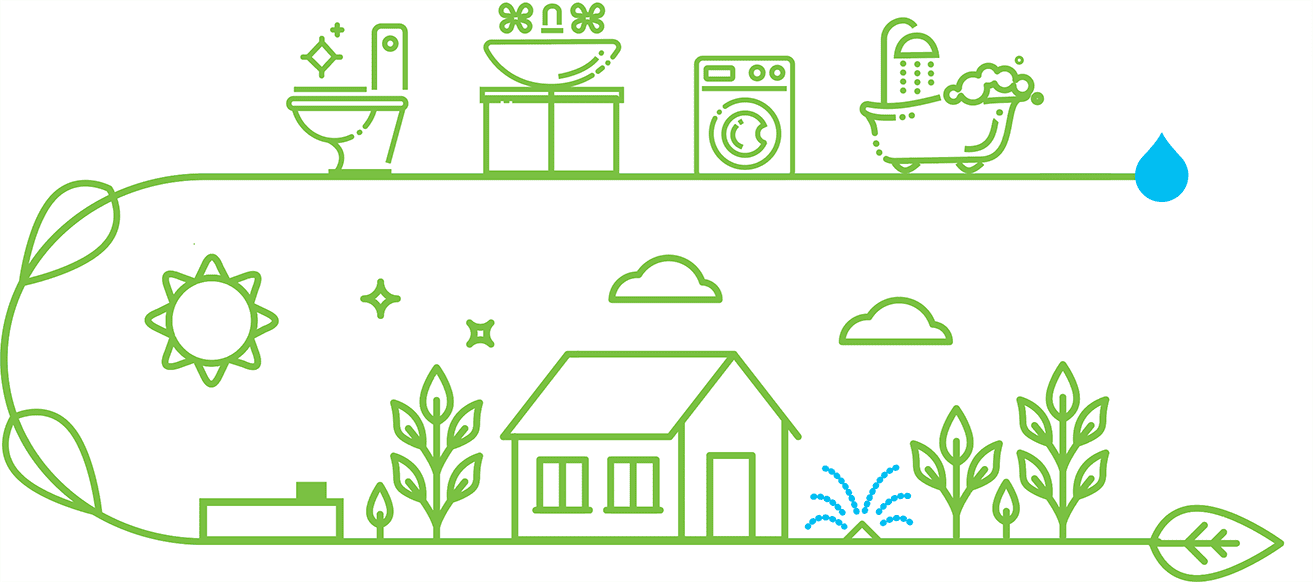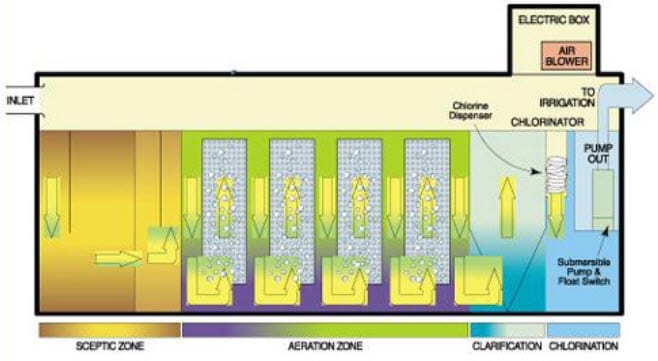Aerated Wastewater Treatment Systems, or AWTS, are self-contained wastewater treatment systems.
Aerated Wastewater Treatment Systems, also known as an AWTS, is a self-contained solution for treating and processing wastewater commonly used for households or small-scale commercial properties. These septic systems employ aeration followed by clarification to biologically treat wastewater, producing a high-quality effluent.
AWTS are typically installed on properties that cannot connect to a reticulated town sewer system and have become the most popular choice for wastewater management today. The advanced treatment process ensures the final effluent is of excellent quality, reducing risks to your family’s health, neighbouring properties, and local waterways. This high-quality effluent is dispersed just below the surface of the ground, effectively reusing the treated water to irrigate gardens and lawns.
These wastewater systems are versatile and can be installed on properties with challenging conditions, such as rocky terrain, sandy soils, high-water tables, steep gradients, or limited space. Aerated Wastewater Treatment Systems are also the preferred choice in environmentally sensitive areas due to their reliability and eco-friendly design.
An AWTS receives and treats all household wastewater from the following sources:
- Kitchen
- Wastewater from sinks, dishwashers, and other kitchen activities.
- Bathrooms
- Water from showers, bathtubs, and bathroom sinks.
- Laundry
- Wastewater from washing machines and laundry tubs.
- Toilets
- Blackwater from toilets, containing human waste and toilet paper.
- Other Household Fixtures
- Any additional drains or fixtures that produce wastewater within the home.
Aerated Wastewater Treatment Systems treats all this wastewater through aeration, biological processes, and clarification, producing a high-quality effluent suitable for safe disposal or reuse for irrigation purposes.

How does an Aerated Wastewater Treatment System (AWTS) work?
AWTS comprises multiple treatment stages, including primary settling, aeration, clarification, and disinfection. Aerated Wastewater Treatment Systems mainly aim to treat wastewater by breaking down organic matter and reducing harmful contaminants before the treated water is discharged into the environment or dispersed via subsurface irrigation.
- Wastewater (influent) enters the primary chamber from the household source.
- In this chamber, the wastewater separates into three layers:
- Scum layer: Fats, oils, and grease (FOGs) float to the surface.
- Effluent layer: Liquids settle in the middle.
- Sludge layer: Solids settle at the bottom.
- The primary-treated effluent flows through a transfer port into the aeration tank, while scum and sludge remain in the primary chamber.
- The aeration tank introduces oxygen into the effluent using an air blower, creating an environment for aerobic bacteria and microorganisms to break down organic matter.
- Media within the tank supports bacteria growth and prevents short-circuiting of wastewater, ensuring thorough aeration.
- This stage effectively digests organic waste and ensures extended biological treatment.
- After aeration, the effluent flows into the clarification chamber, a quiescent zone where suspended particles and solids settle out of the water.
- These particles are returned to the septic or aeration chambers via a sludge return system. This aids in further biological reduction, denitrification, and maintaining a steady microbial population for periods of limited flow.
- Before irrigation, the effluent undergoes disinfection in a chlorinator, which removes harmful bacteria, viruses, and pathogens.
- The automatic chlorinator administers low doses of chlorine to ensure the water is safe for reuse.
- When the final chamber reaches a set level, a float switch activates the irrigation pump, sending the treated effluent to the irrigation field.

This comprehensive treatment process ensures the wastewater is thoroughly treated, producing clean and safe effluent suitable for irrigation while maintaining system efficiency and protecting the environment.
Variations in AWTS Systems
AWTS systems come in various designs and sizes, with their capacity influenced by factors such as:
- The number of users
- Property size
- Local regulations
Compliance with relevant regulatory requirements, along with proper system maintenance and monitoring, is essential for efficient operation and long-term environmental sustainability.
General Guidelines for Aerated Wastewater Treatment System Tank Sizing
Determining the ideal AWTS tank size can be challenging as every property has unique needs. However, AS/NZS 1546.1:2008 provides general guidelines:
- A home with 4–6 bedrooms typically requires a minimum tank size of 4,500L for regular wastewater production.
It’s important to note this is a guideline only. Consulting local wastewater specialists is strongly recommended to ensure your system is appropriately sized and functioning efficiently for your specific circumstances.
Useful Reading:
When Advanced STS is Required
Often, an Advanced STS (Sewage Treatment System) may be necessary instead of an AWTS.
- For further details, consult the NSW EPA’s policies, guidelines, and programs to ensure compliance and make the best choice for your property.
By considering these factors and seeking expert advice, you can ensure your wastewater system operates effectively and sustainably.
“The treated effluent from domestic wastewater treatment systems should not be used for human consumption or to irrigate vegetables or fruit, and the irrigation area should not be used for recreational purposes
Considerations When Choosing a Septic System
We highly recommend reading our Septic Tank Buying Guide, which covers all the primary considerations. Such as:
- Set back distances from houses, structures, waters sources etc
- Types of Septic Tanks and Systems
- The average cost of a septic system
- The process of getting a quote through to the installation
Speaking with an industry professional is an excellent idea to help you choose the best septic system tailored to your site.
Garden Master has been an industry leader for over 30 years, manufacturing, supplying, and servicing quality wastewater treatment systems and septic tanks for thousands of clients across Australia.
Don’t hesitate to call us on 1800 632 582 with any questions!

